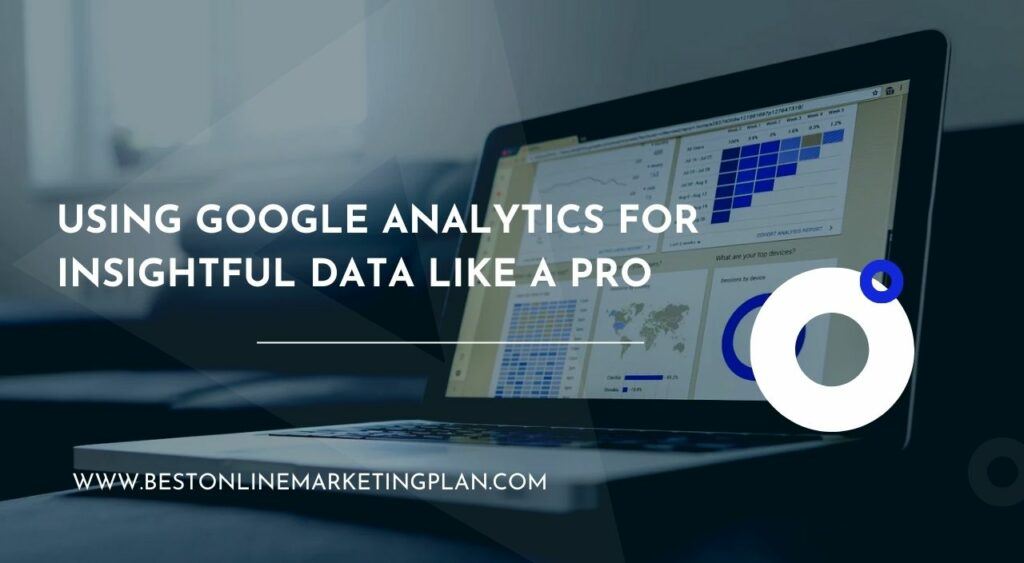Introduction
If you’re reading this, you’re probably excited about using Google Analytics for insightful data. Today, we’re going to explore how this fantastic tool can give you invaluable insights. Whether you’re an expert or a beginner, this guide will show you how to use Google Analytics for insightful data to make smarter decisions. Get ready to turn your raw data into powerful actions that lead to success. Plus, we’ll make the whole process easy and fun!
Table of Contents
ToggleThe Importance of Data-Driven Decision Making
In the digital age, gut feelings and guesswork just don’t cut it anymore. Data-driven decision making is the gold standard, enabling businesses to back their strategies with concrete evidence. By analyzing trends, patterns, and user behaviors, you can make informed choices that optimize performance, enhance customer experience, and ultimately, boost your bottom line.
Understanding Google Analytics: A Brief Overview
Google Analytics is a powerhouse tool that provides comprehensive insights into your website’s performance. It tracks everything from visitor numbers and page views to user demographics and behavior. This vast sea of data can seem overwhelming at first, but with a little guidance, you’ll be navigating it like a seasoned sailor in no time.
Setting Up Google Analytics for Your Website
Creating a Google Analytics Account
The first step is to set up your Google Analytics account. Head over to the Google Analytics website, sign in with your Google account, and follow the prompts to create your profile. You’ll need to provide some basic information about your website, and you’ll be assigned a unique tracking ID.
Integrating Google Analytics with Your Website
Next, you’ll integrate Google Analytics with your site. This involves adding a tracking code to your website’s HTML. This code collects data on user interactions, sending it back to Google Analytics for processing. Most website platforms have plugins or built-in options to make this integration straightforward.

Configuring Basic Settings for Accurate Tracking
To ensure you’re collecting accurate data, configure your settings appropriately:
- Exclude internal traffic
- Set up your site’s time zone
- Enable demographic and interest reports
Proper configuration is crucial for reliable data, so take the time to get this right.
Navigating the Google Analytics Dashboard
Overview of Key Metrics and Reports
Once you’re set up, it’s time to explore the dashboard. Here, you’ll find a wealth of reports and metrics. Key metrics to watch include:
- Sessions: Number of visits to your site
- Users: Unique visitors
- Pageviews: Total pages viewed
- Bounce Rate: Percentage of visitors who leave after viewing only one page
- Average Session Duration: Time spent per visit
These figures give you a snapshot of your site’s performance at a glance.
Customizing Your Dashboard for Quick Insights
To make your life easier, customize your dashboard. You can create widgets for the metrics most important to you, providing quick access to the data that matters most. Custom dashboards save time and help keep your focus sharp.
Audience Insights: Understanding Your Visitors
Analyzing Demographics and Interests
Google Analytics provides detailed reports on your audience’s demographics and interests. This data reveals who your visitors are, including their age, gender, and general interests. Understanding your audience helps tailor your content and marketing efforts to better meet their needs.

Example Table: Audience Demographics
| Demographic | Percentage |
|---|---|
| Age 18-24 | 25% |
| Age 25-34 | 40% |
| Age 35-44 | 20% |
| Age 45+ | 15% |
| Male | 55% |
| Female | 45% |
Tracking User Behavior and Engagement
Beyond demographics, it’s essential to track how users interact with your site. Look at metrics like average session duration and pages per session to gauge engagement. High engagement often correlates with valuable content and user satisfaction.
Segmenting Your Audience for Deeper Insights
For even more granular insights, segment your audience. You can create segments based on various criteria such as new vs. returning visitors, geographic location, or device type. This segmentation allows you to understand different user behaviors and optimize accordingly.
Acquisition Insights: How Users Find Your Site
Tracking Traffic Sources
Knowing where your traffic comes from is crucial. Google Analytics breaks down your traffic sources into categories like organic search, direct, referral, and social. This helps you identify which channels are driving the most traffic and which ones need more attention.
Example List: Traffic Sources
- Organic Search
- Direct
- Referral
- Social
- Paid Search
Evaluating Campaign Performance
If you’re running marketing campaigns, Google Analytics can track their performance. Use UTM parameters to tag your campaign URLs and monitor how they perform. This enables you to see which campaigns are most effective and where to allocate your resources.
Leveraging Referral Data for Growth
Referral data shows you which external sites are sending traffic your way. Building relationships with these referrers can lead to more traffic and potential collaborations. Keep an eye on this data to identify and nurture valuable referral sources.
Behavior Insights: What Users Do on Your Site
Understanding Site Content Reports
Site content reports provide insights into how users interact with your site’s pages. You can see which pages are most popular, how long users stay on them, and the bounce rate for each page. This information is vital for optimizing your content strategy.
Analyzing User Flow and Navigation
User flow reports visualize the path users take through your site. This helps you understand how they navigate from one page to another, highlighting any potential bottlenecks or drop-off points. Smooth navigation enhances user experience and keeps visitors engaged.
Example List: User Flow Stages
- Landing Page
- Navigation Paths
- Drop-off Points
- Conversion Pages
Identifying Top Performing Pages
Identify your top-performing pages and analyze what makes them successful. Is it the content, the design, or the calls to action? Understanding why certain pages perform well can help replicate that success across your site.
Conversion Insights: Measuring Success
Setting Up Goals and Funnels
Conversions are key to measuring success. Set up goals in Google Analytics to track specific actions, like form submissions or purchases. Use funnels to map out the steps leading to a conversion and identify where users drop off.
Example Table: Conversion Funnel
| Step | Conversion Rate |
|---|---|
| Landing Page | 100% |
| Product Page | 70% |
| Cart | 50% |
| Checkout | 30% |
| Purchase | 20% |
Tracking E-commerce Performance
For e-commerce sites, Google Analytics offers robust tracking features. Monitor metrics like revenue, transactions, and average order value to get a clear picture of your store’s performance. Use this data to optimize your product offerings and sales strategies.
Optimizing Conversion Rates
Use the insights gained from your conversion tracking to optimize your site. A/B testing different elements, such as headlines or button colors, can help improve conversion rates. Continuous testing and tweaking lead to incremental improvements and greater success.
Advanced Google Analytics Features
Using Advanced Segments for Detailed Analysis
Advanced segments allow for a deeper dive into your data. Create segments to isolate specific user groups and analyze their behavior. This detailed analysis can uncover trends and opportunities you might otherwise miss.
Setting Up Custom Dimensions and Metrics
Custom dimensions and metrics enable you to track data specific to your business needs. Whether it’s tracking the performance of logged-in vs. guest users or monitoring custom events, these advanced features provide tailored insights.
Leveraging Event Tracking for User Interactions
Event tracking lets you monitor specific interactions on your site, such as button clicks, video plays, or downloads. This data helps you understand how users engage with your content and identify opportunities for improvement.
Using Google Analytics with Other Tools
Integrating Google Search Console for SEO Insights
Google Search Console integration provides additional SEO insights. You can see which queries bring users to your site, monitor your site’s search performance, and identify areas for improvement. SEO insights are invaluable for driving organic traffic.
Connecting with Google Ads for Campaign Optimization
Linking Google Analytics with Google Ads allows for detailed campaign performance analysis. Track how users from your ads interact with your site and measure the ROI of your ad spend. This integration helps optimize your advertising strategy for better results.
Creating Custom Reports for Deeper Insights
Building Reports with Google Data Studio
Google Data Studio allows you to create custom, visually appealing reports. Combine data from Google Analytics and other sources to build comprehensive reports that provide deep insights. Custom reports help you and your team make informed decisions.
Example Table: Custom Report Components
| Component | Description |
|---|---|
| Data Source | Google Analytics, Google Ads |
| Metrics | Sessions, Conversions, Revenue |
| Visualization | Charts, Graphs, Tables |
| Filters | Date Range, User Segments |
Automating Reports for Regular Updates
Save time by automating your reports. Set up scheduled emails to receive regular updates on key metrics and performance indicators. Automated reports ensure you stay informed without the manual effort.
Troubleshooting Common Google Analytics Issues
Resolving Tracking Discrepancies
Sometimes, you might notice discrepancies in your data. These can arise from various issues like incorrect tracking code implementation or filters affecting your data. Identifying and resolving these discrepancies is crucial for maintaining data accuracy.
Ensuring Data Accuracy
Ensure your data is accurate by regularly auditing your Google Analytics setup. Check for broken tracking codes, verify settings, and make sure your goals and funnels are working correctly. Accurate data is the foundation of reliable insights.
Staying Up-to-Date with Google Analytics
Following Google Analytics Updates and Trends
Google Analytics is continually evolving. Stay up-to-date with the latest updates, features, and best practices by following Google’s announcements and industry blogs. Keeping informed helps you leverage the latest tools and techniques, ensuring that you are always at the forefront of data analysis.
Learning Resources and Community Support
There are numerous resources available to help you master Google Analytics. From Google’s own training courses to community forums and blogs, you’ll find plenty of support. Engaging with the community can provide valuable insights and tips, helping you troubleshoot issues and discover new ways to optimize your data strategy.
Example List: Learning Resources
- Google Analytics Academy
- Online tutorials and webinars
- Community forums and discussion groups
- Industry blogs and newsletters
- Local user groups and meetups
Conclusion
Final Thoughts on Using Google Analytics for Insightful Data
Using Google Analytics for insightful data takes some time and practice, but trust me, it’s totally worth it. Once you get the hang of it, you’ll gain amazing insights into your website’s performance and make smart, data-driven decisions that lead to success. Keep exploring its features, carefully analyze your data, and use what you learn to fine-tune your strategies.
If you want to take your online business to the next level, I highly recommend signing up for a free account with Wealthy Affiliate. It’s the best affiliate training out there, and you can decide later if you want to go premium for even more benefits at a low cost. Before you join, check out the Wealthy Affiliate Review to see what it’s all about. You’ll find that it’s a great way to learn, grow, and succeed online. So go ahead, give it a try, and start using Google Analytics for insightful data to make the most of your online journey!
Encouragement to Continuously Analyze and Improve
The journey doesn’t end here. Continuously analyze your data, experiment with new strategies, and refine your approach. The digital landscape is always changing, and staying proactive will keep you ahead of the curve. Embrace the power of Google Analytics, and let data drive your success. Happy analyzing!
5 Source Links for Further Study
Certainly! Here are five valuable resources for further study on using Google Analytics:
1. [Google Analytics Academy]
– Offers free online courses on various aspects of Google Analytics, from beginner to advanced levels.
2. [Google Analytics Help Center]
– Comprehensive resource for troubleshooting, tutorials, and detailed documentation on all Google Analytics features.
3. [Moz – Beginner’s Guide to Google Analytics]
– An in-depth guide covering the basics of Google Analytics, ideal for those new to the tool.
4. [The Ultimate Guide to Google Analytics by Neil Patel]
– A thorough guide by digital marketing expert Neil Patel, covering advanced tips and tricks.
5. [Analytics Mania Blog]
– Offers a wealth of articles, tutorials, and best practices on Google Analytics, GTM, and other related tools.

